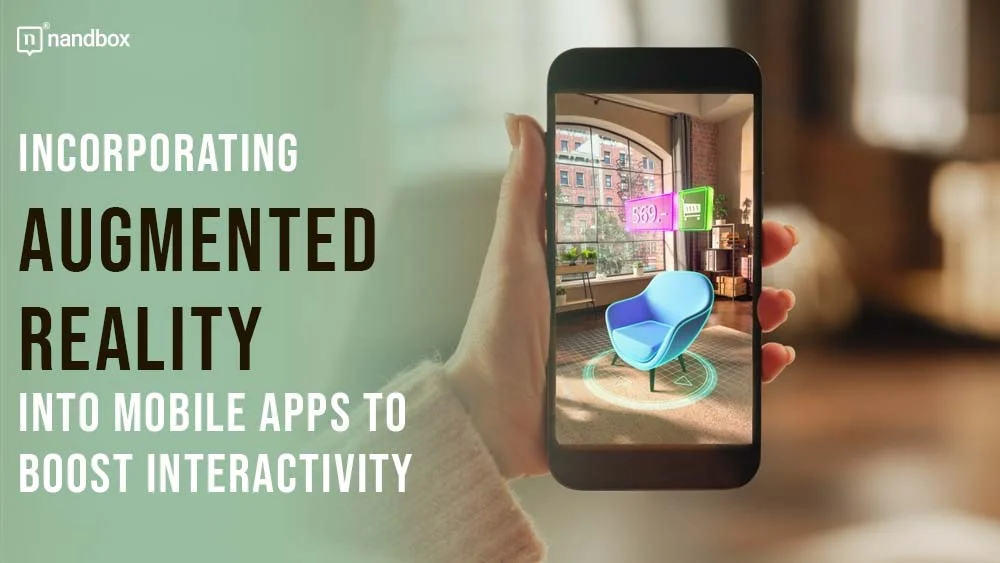Integrating Augmented Reality (AR) into Mobile Apps for Enhanced Interactivity
Between 2022 and 2023, app downloads were 257 billion installations, indicating slow growth compared to the past. It may be the perfect time for developers to embrace the harsh reality and come up with new ideas to integrate into their applications. One of the viable and popular options is augmented reality (AR), which engages users in interactive experiences.
- What are the key features of AR?
- What role does AR play in mobile applications?
- How can AR contribute to the development of mobile apps?
- How can immersive technology be used in different mobile applications?
- What are the possible obstacles when developing AR-equipped mobile apps?
Let’s get straight to the point and discover the potential of immersive technology in mobile applications.
Digital Transformation with AR Evolution
Augmented reality is one of those breakthroughs shaking up the digital world in different industries. At the core of its potential lies the ability to bring a digital layer to what you see around yourself through your phone camera, with images, videos, or 3D models. This sort of thing is pretty similar to virtual reality (VR), but AR doesn’t create a whole new world.
Basically, the AR feature upgrades how we see reality by mixing in digital stuff. It uses fancy tools and software to blend virtual things with our surroundings. That allows for intensifying what’s already there and enriching experiences. The system relies on the following:
- Sensors – cameras, GPS, and accelerometers.
- Computer vision – object recognition and scene understanding.
- Display systems – HMDs, smartphones, and smart glasses.
- Processing power – real-time data processing and 3D rendering.
- Algorithms – image recognition, object tracking, and spatial mapping.
- Networking – cloud access and multiplayer experiences.
- User interfaces – gestures, voice commands, and touch controls.
- Content creation – 3D modeling and AR development tools.
The first device resembling the AR technology we currently use can be traced back to the late 1960s. In 1968, Ivan Sutherland constructed the earliest head-mounted display. This breakthrough meant the inevitable broader development and acceptance of the newly developed solution.
The key to AR’s tremendous rise today is the emergence of high-end smartphones—they’ve made immersive tech accessible to millions. With their top-notch processors and cameras, phones enable creators to produce engrossing encounters that used to require expensive gear.
How Augmented Reality Impacts Mobile Applications
Today, the AR field continues to evolve thanks to the advent of better hardware and software. Smartphones, with their fancy cameras and sensors, helped push AR into our daily routines. Now, just tapping a screen can open up a world where digital and real-life mix seamlessly, changing how we do everything from work to play.
As using smartphones has become one of the daily routines in the lives of many people, AR tech has been particularly significant for app makers lately. This feature is rapidly growing in mobile applications, and every user wants to know now how awesome it can be. That’s why developers prefer AR to modernize their products, making them way more fun and immersive for users.
As AR is getting so popular, there are tons of tools and frameworks out there now that focus on this technology. This makes it easier for the creators to jump into making top-notch software. The AR trend is also pushing innovation, with businesses finding new ways to employ it and make their products stand out. As the interactive system keeps getting better, it’s clear it’s going to shake up the app world even more.
What Opportunities AR Offers to the Development of Mobile Apps
As the immersive technology is specifically created for mobile devices, its benefits can’t be overlooked for apps. Mobile apps are getting ready to provide users with amazing experiences that smoothly mix real-life and virtual environments. Thanks to recent technological progress, integrating AR into iOS and Android applications has become a revolutionary development for businesses everywhere, opening up countless possibilities.
Integrating AR technology through mobile game development services enables developers to create engaging games that offer a seamless blend of real-world and virtual elements. By leveraging development services, businesses can enhance user engagement and provide innovative gaming experiences that capitalize on AR capabilities.
Inventive Experiences
Using AR helps engineers create new and imaginative environments inside mobile applications. This innovation enhances user behaviors, making applications more appealing and memorable.
Better User Engagement
AR is changing how we use mobile apps, making them way more entertaining. When developers add the AR feature, it can make things more fun and fun to use. For instance, it’s possible to try lifelike clothes in retail apps. At the same time, meditation apps can transport users to tranquil settings, thereby amplifying the efficacy of their routines.
Enhanced Brand Visibility and Revenue
Using AR can really amp up how many customers see your brand and make your product more profitable. AR marketing, cool product demos, and virtual try-ons grab people’s interest and make them more likely to buy and remember your business.
Examples of Using AR in Different Mobile Apps
The fast-paced development of AR has had an impact on many industries. Let’s dig into all the cool things businesses can achieve by integrating immersive technology into mobile apps.
- E-commerce. Using AR lets stores create immersive shopping, so customers can see how products look in their space before placing an order. Trying on virtual clothes or seeing how the furniture fits at home with digital reality can make shopping more fun and reduce returns later on.
- Education. AR makes learning cooler by adding interactive and immersive learning content. For instance, users can take historical tours with immersive landmarks. It’s a fun way to learn that sticks in your memory and works for learners of any age.
- Healthcare. AR is making waves in apps related to the health sector, helping medical pros see patient anatomy and do procedures more accurately.
These examples show how various industries use immersive technology to deliver more awesome interaction opportunities. With AR, businesses can offer innovative and fun experiences that keep their customers happy and returning for more.
To effectively implement these AR features, companies may seek mobile development services that integrate advanced technologies into user-friendly applications. Partnering with experienced mobile development services ensures that AR functionalities are seamlessly incorporated, enhancing user engagement and operational efficiency.
The Best Strategies for Integrating Augmented Reality in Mobile Apps for Enhanced Interactivity
AR in mobile apps isn’t just trendy; they’re changing how users engage. AR enhances real-world experiences, VR immerses users, and both offer new opportunities for businesses and developers. Creating high-quality AR apps requires strategic consideration of different aspects.
To ensure user data privacy while using AR applications, integrating a self-hosted password manager can provide secure authentication solutions. Utilizing a self-hosted password manager allows developers to maintain control over the storage and management of sensitive information, enhancing security.
Determine the Intended Result
Make sure you clearly define your goals before adding immersive features to your mobile app. These goals should match the app’s overall purpose and the people you’re trying to reach. The list of possible desired outcomes may range from enhancing user involvement and improving sales to offering practical tools. Whatever you want to achieve, AR must perform a clear and valuable role within the app’s structure.
Choose the Right Framework
Different AR development environments offer unique strengths and capabilities. The list of options offers different choices, including ARKit, ARCore, Vuforia, etc. They all have pros and cons, so take a wise approach in picking what is suitable for your app.
Focus on Simplicity
Creating a user-friendly interface is critical to the success of AR apps. It’s all about making sure users can interact with virtual content in the real world without confusion. Include clear instructions, tutorials, or tooltips within the app to guide users through their initial AR interactions. This way, everyone will quickly understand how to navigate the AR features and enjoy their experience from the start.
Blend AR Features Seamlessly
Integrating innovative technology easily with current app content and functionality is paramount. This requires maintaining a consistent user experience across AR and non-AR elements. Ultimately, users will be able to smoothly shift between virtual and real-world activities, increasing engagement and maximizing the app’s total appeal.
To achieve this seamless integration, many companies opt for nearshore software development services that can provide the specialized skills needed for sophisticated AR applications. These nearshore software development teams work closely with businesses to ensure a harmonious user experience that blends new technologies effectively.
Perform Consistent Testing and Gather Feedback
Thoroughly testing any AR app is highly important. This approach allows you to find and fix any problems or slowdowns. The process must include different devices, various settings, as well as real users. This helps collect valuable customer input to refine and enhance the AR experience over time.
Possible Challenges
Developing AR-based mobile apps offers exciting possibilities for immersive user experiences, but it also presents multiple obstacles to overcome. For instance, accurately tracking and responding to changes in real-time environments is a complex task. This demands advanced algorithms, which may overwhelm device hardware resources.
The associated costs are one more challenge to consider. Creating an AR mobile app alone is pretty expensive. Moreover, developing top-notch products requires specialized skills and tools, requiring developers to stay updated with the latest tech trends.
Despite the challenges, the opportunities for implementing AR in mobile applications are much greater. Overcoming these hurdles allows developers to craft products that are not just engaging and innovative but also useful, making them stand out in a competitive market. Success hinges on understanding the audience’s needs and preferences and wisely using AR to fulfill them.
Conclusion
AR technology puts digital products right into the real world, making interactions cooler and blurring what’s real and what’s not. When businesses use AR in apps, they can totally change how their offerings are seen, make engaging with customers smoother, and create experiences users won’t forget.
The immersive feature can be beneficial for mobile apps in different industries. When businesses grasp and tackle the hurdles and benefits of integrating AR into mobile apps, they can fully tap into this game-changing tech and craft cool and captivating experiences for their customers.
Author bio:
Roy Emmerson is the co-founder of TechTimes.com, a B2B SaaS platform that helps businesses stay up-to-date on the latest technology trends. With over a decade of experience in the tech industry, Roy is a thought leader in the field and is passionate about helping companies embrace new technologies to improve their operations and drive growth.






